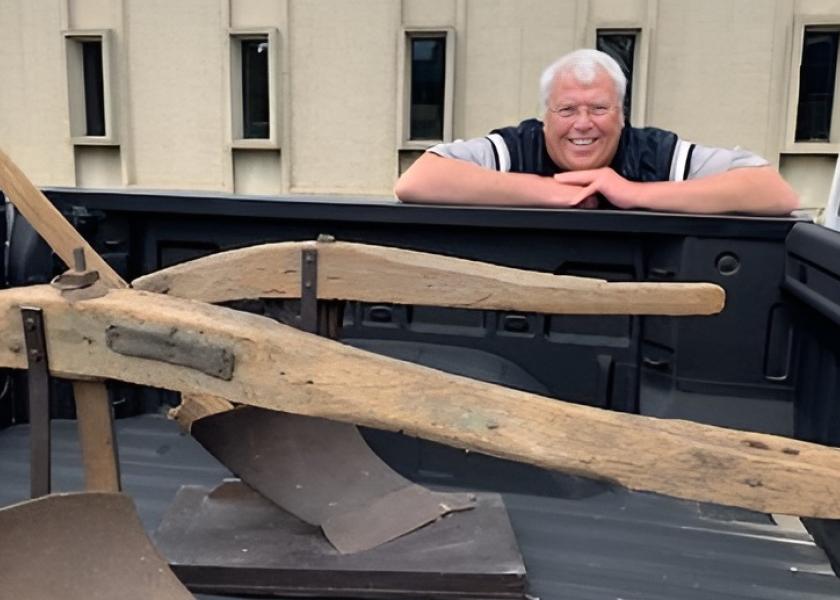Purdue University’s latest Consumer Food Insights Report shows 60 percent of consumers are...
Holy Grails of U.S. History - Two Plows Forged by John Deere Hidden on Iowa Farm

Twin grails that changed U.S. history—a pair of steel, moldboard plows crafted in the flesh by the hands of John Deere and bought directly from the American titan’s Illinois shop in 1839 and 1840—sit behind unassuming garage doors on Sam Shaff’s Iowa farm.
Purchased by Shaff’s great-great grandfather, Heman Shaff, the 1839 specimen was the first Deere plow on Iowa farmland, and possibly the first to break dirt on the far side of the Mississippi River during America’s westward expansion.
“My family bought the plows directly from John Deere,” Sam Shaff says, “and the accounts I was told that Deere was an extremely busy, but very nice gentleman. The first plow cost $24, and all the neighbors wanted a turn to use it.”
The Plow Wonder
On 1,000 acres of corn and soybeans in eastern Iowa’s Clinton County, a stone’s throw from the Mississippi River outside Camanche, the oldest continuous farm in Iowa is overseen by seventh-generation producer Sam Shaff. “Like with a lot of people, my family history gets richer the older I get.”
However, Shaff’s modesty can’t hide an exceptionally deep farm and family story.
On December 13, 1837, Heman Shaff registered a claim on 240 acres of black dirt near the fork of the Mississippi and Wapsipinicon rivers in present-day Clinton County. At the end of 1838, Heman moved the Shaff family across the Mississippi River, either by skiff or ferry, and broke virgin soil on 240 acres of Camanche dirt. Prior to his departure from Illinois, or just after his arrival in Iowa, Heman heard accounts of a plow wonder made by an innovative blacksmith—Mr. John Deere.
Magical Moldboard
In the age of American plow wars, westward expansion spurred ever-greater demand for a better implement, yet the plow void remained. In 1836, facing bankruptcy and down to his last $73, John Deere, 32, bounced out of Vermont and set up a blacksmith business in northwest Illinois’ Grand Detour. In 1837, inside a 26’-by-31’ shop on the Rock River, Deere solved the plow riddle. His solution? Sleek, polished steel.
Deere built a self-scouring steel plow—an answer to the drag of cast iron and sticky prairie soils of the Midwest. Although production numbers soon would explode, Deere initially crafted plows according to individual demand. In 1837, he produced a single steel plow. In 1838, he made two plows. In 1839, he quintupled production to 10 plows. And that same year—1839—Heman Shaff crossed the Mississippi River, rode 60 miles, and knocked on Deere’s door, anxious to buy one of 10 magical moldboards.
Forever Steel
“Twenty-four dollars,” Shaff says. “Heman went all the way to Grand Detour and bought the plow personally from Deere.”
Loaded onto his wagon, Heman returned to Camanche with the first Deere steel moldboard used on Iowa farmland—and possibly the first Deere steel plow used west of the Mississippi River.
Pulled by oxen, how did the tool perform on Iowa ground? “It did the job like nothing else,” Shaff says. “The neighbors couldn’t get over how well it worked, and they borrowed it at night, literally plowing by lantern light. It worked so well that Heman went back to Deere’s shop in Grand Detour in 1840 and bought another.”
“I have the oldest farm in Iowa, but there’s so much about my family history even I don’t know,” Shaff says. However, a certainty housed in Shaff’s farm garage brings him immense satisfaction. “I’m protecting two of Deere’s plows—personally made by him and personally sold by him almost 200 years ago.”
Simply, Shaff owns steel that forever changed agriculture and America.
EDITOR’S TAKE:
What an amazing story about a piece of American and agricultural history! Typically machinery of this nature is thrown onto the junk pile and long forgotten by now. But someone had the foresight and wisdom to put these plows in a safe environment and preserve them for posterity. These two plows are worth a lot of money today, but that aside, it is exciting just to know that John Deere handcrafted these implements. The other thing about this story, it demonstrates just how far agriculture has advanced in the almost 200 years since those plows were produced. A story like this should make you proud to be part of an exciting industry like agriculture. As a CAD member, you are contributing to the traditions and history of American agriculture today!








